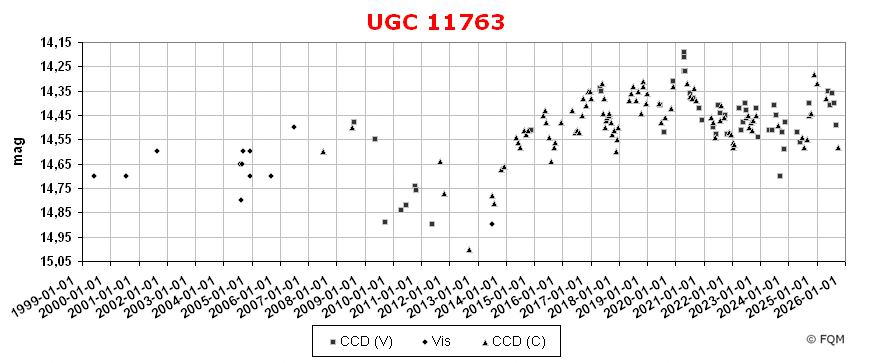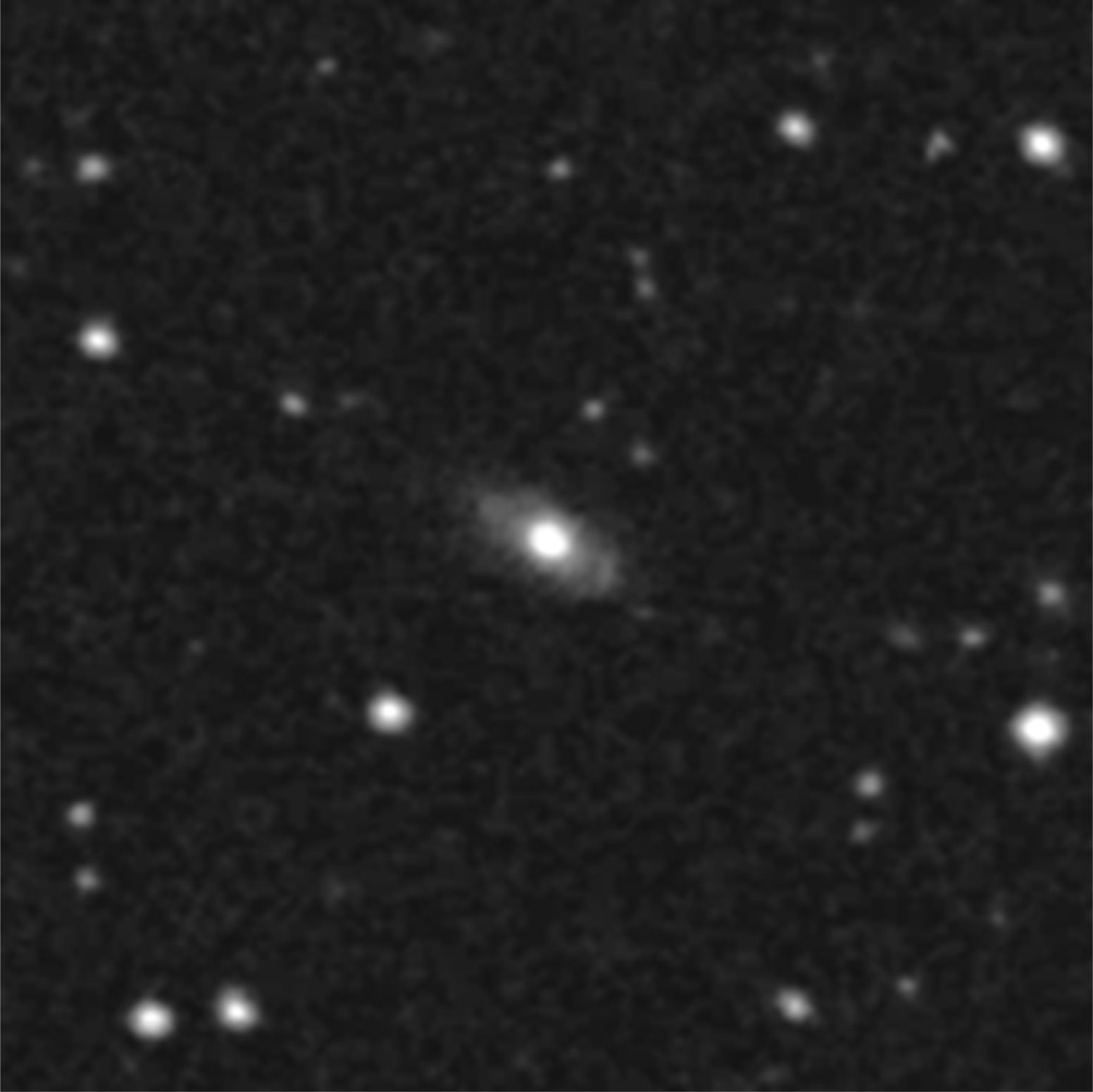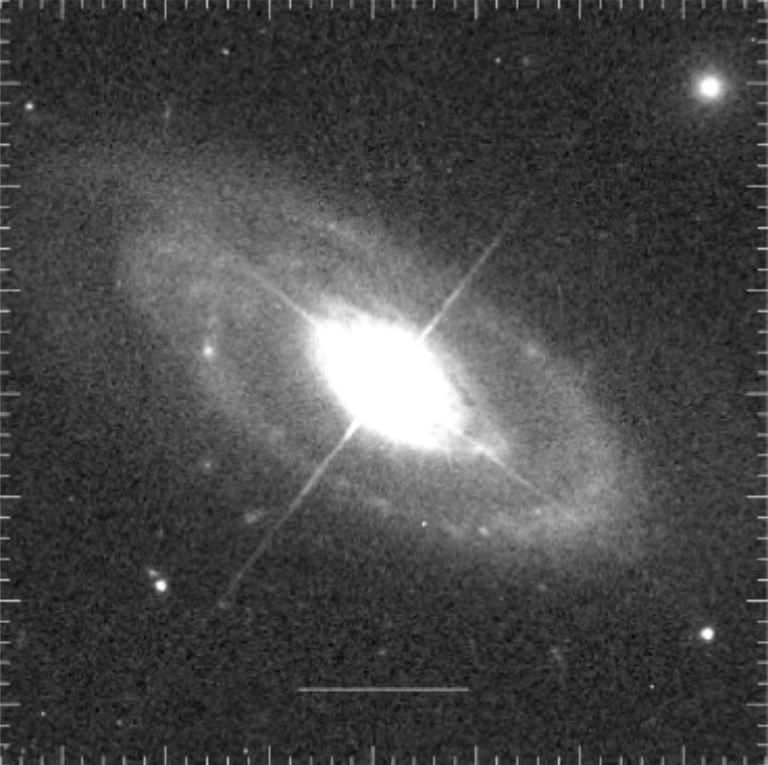
| Frankfurt Quasar Monitoring |
| UGC 11763 = II Zw 136 = PG 2130+099 |
| Cross-Identifications | II Zw 136, PGC 66930, MRK 1513, UGC 11763 QSO B2130+099, Zw II 2130+09, PG 2130+099 RX J2132.4+1008, SDSS J213227.81+100819.1 2XMM J213227.8+100819, [HB89] 2130+099 EUVE J2132+10.1, IRAS 21299+0954 |
| Equat. coordinates | RA 21 32 27.8 DE +10 08 19 (J2000) |
| Constellation | Pegasus |
| Type (1) | AGN |
| Redshift |
z=0.061 (1) (6) / z=0.063 (2) |
| Distance (2) (3) |
251 Mpc |
| Total mag range (mv) (4) (5) | 14.1 - 15.0 |
| Catalog Magnitude (1) | 14.64 |
| Absolute Magnitude (1) | -22.9 MB |
| Light Travel-Time (2) | 0.794 × 109 yrs |

| star | B | V | Rc | Ic |
| 3 | 16.109
(0.081) |
15.394
(0.009) |
14.978
(0.009) |
14.656
(0.012) |
| 4 | 16.183
(0.066) |
15.201
(0.011) |
14.735
(0.005) |
14.399
(0.005) |
| 9 | 15.708
(0.061) |
14.741
(0.005) |
14.266
(0.004) |
13.864
(0.002) |
| 10 | 15.381
(0.021) |
14.494
(0.005) |
14.069
(0.002) |
13.684
(0.004) |
| 11 | 17.235
(0.078) |
16.038
(0.025) |
15.480
(0.008) |
14.987
(0.006) |
| 13 | 14.831
(0.013) |
13.848
(0.002) |
13.328
(0.003) |
12.928
(0.003) |
| 15 | 13.758
(0.014) |
13.079
(0.007) |
12.722
(0.005) |
12.443
(0.006) |


 Credit: DSS2R /
Size 3´× 3´
UGC 11763 as an elongated galaxy disk with a bright starlike nucleus (app. diam. 25"×10" / N up, E left) |
 Credit: Surace et
al. (2001) / Size 37"× 37"
shows the quasar host as a well-resolved spiral galaxy with a very prominent core (Image inverted / N up, E left) |
| UGC 11763, also known as II
Zw 136 and MRK 1513, is a bright AGN in south-western Pegasus, close to
the constellation Equuleus. UGC
11763 was discovered in 1965 by Fritz Zwicky, who described this
14-mag compact galaxy as a "variable very blue spherical, very
compact". Follow-up spectroscopic investigations in 1967 revealed a
Seyfert
1-spectrum, which led to the classification as a Narrow-Line Seyfert
1-galaxy (NLS1). By the mid 1980s, this AGN was reclassified as a
quasar (radio-quiet,
low luminosity quasar). Since 2001, Véron-Cetty et al. have
redetermined
the
absolute luminosity to -22.9 MB, which does
not meet their quasar
classification criterion of -23.0 MB
any
longer. But this AGN shows an optical variability by about 1 magnitude.
So in this case, a strict classification of either QSO or AGN is
difficult. The compact galaxy UGC 11763 was first
catalogued as a blue (see colour
chart above) and UV-bright object in 1973 by Markarian (MRK), then
again in 1986 by
the Palomar-Green Bright
Quasar
Survey
(PG), and finally by the International Ultraviolet Explorer
IUE in 1978-1980. In addition, the AGN was found to be an infrared
source by IRAS in 1983,
as well as an X-ray emitter later on (Exosat
1985, Einstein (2E), ROSAT (RX)). UGC 11763 is a distorted spiral galaxy with a true diameter of 30 kpc, inclined 60° from face-on (see image above). The galaxy centre is dominated by a very bright and active nucleus. The peculiar ring-like spiral arm pattern is considered as a result of interaction with at least one companion galaxy and/or some kind of post merger state. UGC 11763 is a weakly variable object with a total range of only about 1 magnitude (14.1-15.0 mag). Visual observers need at least an 8- to 10-inch telescope or larger to glimpse this stellar object. With large aperture telescopes UGC 11763 becomes more star-like, although it is quite difficult to recognize the galaxy disk as a very faint elongated halo around the prominent core. CCD observers, as well as visual observers, shall use the comparison stars given above. Other sequences were published by Miller (1981) and Penston et al. (1971). A notice to the photometrists: Do not use comparison star #15. This star was recently found to be variable (probably type W UMa). ____________
Locating UGC 11763 is quite easy due to its proximity to Epsilon (8) Pegasi, only 2.9° W. One deep sky showpiece near UGC 11763 shall not be missed: globular cluster M15. This is one of the brightest globular clusters in the northern sky (6.2 mag) and is located only 2° N of UGC 11763. M15 appears bright and large with a very dense core. Inside M15, large aperture telescopes may reveal a very special object: Pease 1, a faint planetary nebula, only 3” in diameter Stargazers who like to observe more very old quasi-stellar photons may turn to quasar 3C 304, a bright 14-mag object at the same distance as UGC 11763, located 11.7° ENE of UGC 11763. |
| Comastri, A., Setti, G., et al. 1992, ApJ, 384, 62; EXOSAT X-ray Spectra of Quasars. Doroshenko, V.T. 2013, PZ 33, 5; BVRI CCD Photometry of Two New Variable Stars in the Field of Seyfert 1 Galaxies Mrk 478 and Mrk 1513. Fairall, A.P. 1968, PASP, 80, 235; A New Bright Seyfert-Type Galaxy - Zw II 2130+09. Giveon, U., Maoz, D., et al. 1999, MNRAS, 306, 637G; Long-term Optical Variability Properties of the Palomar-Green Quasars. Gonzŕlez-Pérez, J.N., et al. 2001, AJ, 122, 2055; Optical and Near-Infrared Calibration of AGN Field Stars: An All-Sky Network of Faint Stars Calibrated on the Landolt System. de Grijp, M.H.K., Miley, G.K., Lub, J. 1987, A&AS, 70, 95; Warm IRAS Sources - A Catalogue of AGN Candidates from the Point Source Catalogue (PSC). Hansen, T. 1991, Deep Sky Magazine 34, 32; The "Deepest" Deep Sky Objects. Hutchings, J.B., Crampton, D., Campbell, B. 1984, ApJ, 280, 41; Optical Imaging of 78 Quasars and Host Galaxies. Hutchings, J.B., Neff, S.G. 1992, AJ, 104, 1; Optical Imaging of QSOs with 0.5 arcsec Resolution. Karge, S.; Helle Quasare für 8- bis 10-Zoll Teleskope. Ein Beobachtungsführer zur visuellen Beobachtung von Quasaren und BL Lacertae Objekten; Frankfurt 2005. Khachikian, E., Weedman, D. 1974, ApJ, 192, 581; An Atlas of Seyfert Galaxies. Kojoian, G., Tovmassian, H.M., et al. 1980, AJ, 85, 1462; Radio Survey of Markarian Galaxies at 6 and 11 cm. Lloyd, C. 1984, MNRAS, 209, 697; Optical Monitoring of Radio Sources. Miller, H.R. 1981, AJ, 86, 87; Photoelectric Comparison Sequences in the Fields of Five Seyfert Galaxies. Neugebauer, G., Miley, G.K., et al. 1986, ApJ, 308, 815; Quasars Measured by the Infrared Astronomical Satellite. Nilson, P. 1973; Uppsala General Catalogue of Galaxies; Acta Universitatis Upsaliensis, Nova Regiae Societatis Upsaliensis, Series V: A Vol 1. Osterbrock, D.E. 1977, ApJ, 215, 733; Spectrophotometry of Seyfert 1 Galaxies. Penston, M.J., Penston, M.V., Sandage, A.R. 1971, PASP, 83, 783; Stars Observed Photoelectrically Near Quasars and Related Objects. Sargent, W.L.W. 1970, ApJ, 160, 405; A Spectroscopic Survey of Compact and Peculiar Galaxies. Schmidt, M., Green, R.F. 1983, ApJ, 269, 352; Quasar Evolution Derived from the Palomar Bright Quasar Survey and Other Complete Quasar Surveys. Steinicke, W.; Katalog heller Quasare und BL Lacertae Objekte; Umkirch 1998. Steinicke, W.; Beobachtungsliste für helle Quasare; Umkirch 1999. Surace, J.A., Sanders, D.B., Evans, A.S. 2001, AJ, 122, 2791; Optical and Near-Infrared Imaging of Infrared-Excess Palomar-Green Quasars. Véron-Cetty, M.-P., Véron, P. 2001, A&A 374, 92; A Catalogue of Quasars and Active Nuclei: 10th edition. Véron-Cetty, M.-P., Véron, P. 2003, A&A 412, 399; A Catalogue of Quasars and Active Nuclei: 11th edition. Véron-Cetty, M.-P., Véron, P. 2006, A&A 455, 776; A Catalogue of Quasars and Active Nuclei: 12th edition. Véron-Cetty, M.-P., Véron, P. 2010, A&A 518, 10; A Catalogue of Quasars and Active Nuclei: 13th edition. Wilkes, B.J., et al. 1999, ApJ, 513, 76; Investigation of the Relation between the Spectral Energy Distributions and the Emission Lines in Low-Redshift Quasars. Zwicky, F., Zwicky, M.A.; Catalogue of Selected Compact Galaxies and of Post-Eruptive Galaxies; Zürich 1971. |
| Link: 2130+099 (Sasmirala, Univ. of Heidelberg) |
| home |